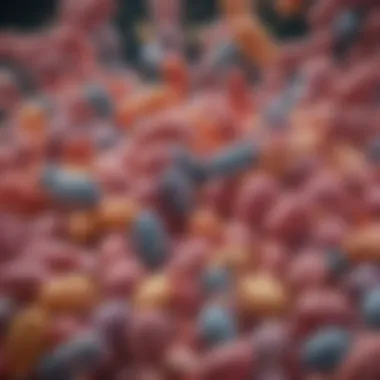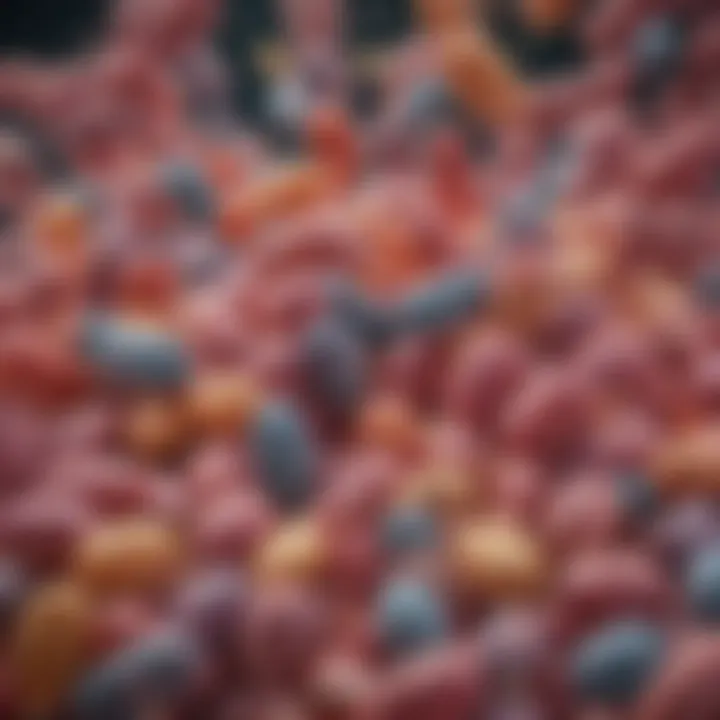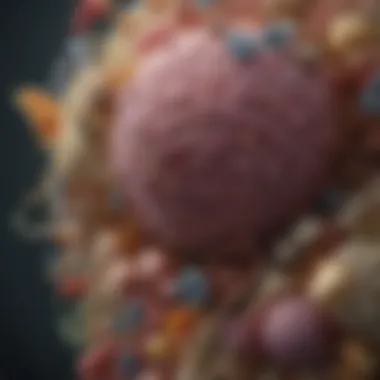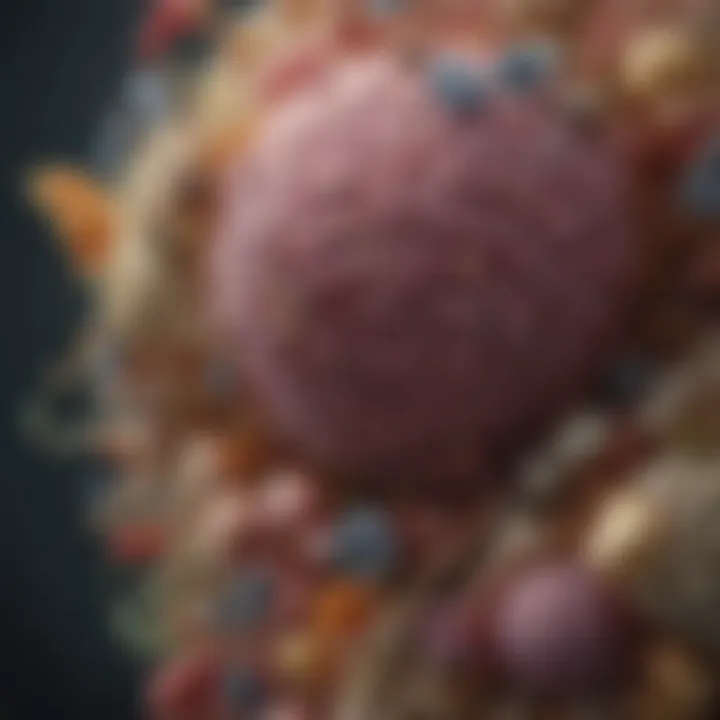Antibiotics and Their Impact on Gut Microbiota


Intro
The interaction between antibiotics and intestinal bacteria presents a compelling area of study within the realm of microbiology. Understanding how these medications influence the gut microbiota is crucial for determining their broader implications for human health. Antibiotics have been reliable tools in combatting bacterial infections for decades; however, their impact on the community of microorganisms residing in our intestines can be complex and varied. This article will examine these interactions, shedding light on the effects of antibiotics on bacterial diversity and what that means for individual health outcomes.
The gut microbiome consists of diverse communities of bacteria that play significant roles in digestion, metabolism, and immune function. Disruption of this delicate ecological balance can lead to adverse health effects, including gastrointestinal disorders, infections, and even chronic diseases. Given the increasing reliance on antibiotics in both healthcare and agriculture, it is vital to explore not only their therapeutic benefits but also their potential risks to gut health. This exploration will serve as a basis for understanding how we can foster a better recovery of gut microbiota post-antibiotic treatment, possibly through the use of probiotics and dietary strategies.
In the subsequent sections, we will delve deeper into the methodology used for studying the effects of antibiotics on intestinal bacteria, examine the future directions of this field, and provide practical recommendations for maintaining gut health after antibiotic use.
Prelims
The interplay between antibiotics and intestinal bacteria is a crucial topic in current medical research. It informs us about not just the effectiveness of antibiotics but also the broader implications on gut health and overall wellbeing. Understanding this relationship allows healthcare professionals to make informed decisions regarding antibiotic prescriptions, thereby optimizing treatment while minimizing negative impacts on gut microbiota.
Antibiotics have revolutionized modern medicine, providing vital treatment options against various bacterial infections. However, their use comes with a price, particularly concerning the balance of the gut microbiome. Disruption of this balance can lead to a range of health issues, from mild gastrointestinal disturbances to more severe conditions.
Exploring this topic highlights the importance of responsible antibiotic use, patient education, and the potential for recovery strategies post-treatment. As such, understanding the nuances of antibiotics and their effects on intestinal bacteria remains a priority for researchers, educators, and practitioners across the health sciences.
Overview of Antibiotics
Antibiotics are substances that inhibit the growth of bacteria or kill them outright. They can be categorized into several classes based on their structure and mechanism of action, such as penicillins, cephalosporins, and macrolides. Each class works differently, targeting specific bacterial functions or structures. For instance, penicillins disrupt the formation of the bacterial cell wall, while macrolides inhibit protein synthesis within the bacterium.
In clinical settings, antibiotics are often prescribed to treat infections caused by bacteria, including pneumonia, strep throat, and urinary tract infections. Despite their effectiveness, the overuse and misuse of these drugs have led to a significant increase in antibiotic-resistant strains, posing a major public health challenge.
The importance of adhering to prescribed antibiotic regimens cannot be overstated. Not only does this practice help in effectively treating the infection, but it also mitigates the risk of resistance development.
Understanding Intestinal Bacteria
The gastrointestinal tract houses trillions of microorganisms, primarily bacteria, which form the gut microbiome. This ecosystem plays an essential role in digesting food, producing vitamins, and training the immune system. A balanced gut microbiota is vital for maintaining health and preventing diseases.
Intestinal bacteria can be broadly classified into two categories: beneficial and pathogenic. Beneficial bacteria, like Lactobacillus and Bifidobacterium, support digestion and bolster the immune response. Pathogenic bacteria, on the other hand, can lead to infections and gastrointestinal disorders.
When antibiotics are introduced into this delicate balance, they target both harmful and beneficial bacteria, leading to decreased diversity within the microbiome. This disruption can result in various issues, emphasizing the need for further research into ways to preserve or restore gut health post-antibiotic treatment.
Mechanisms of Action
Understanding the mechanisms of action of antibiotics is vital for grasping their broader impacts on intestinal bacteria. Antibiotics are designed to target specific biological processes in bacteria. This targeted approach not only helps to eliminate pathogenic bacteria but also poses risks to the beneficial bacteria that comprise the gut microbiome. Therefore, dissecting how these drugs work contributes significantly to our knowledge of their consequences.
How Antibiotics Target Bacteria


Antibiotics primarily function by disrupting essential processes in bacterial cells. The mechanisms can vary widely among different antibiotic classes. Some common ways include:
- Inhibition of Cell Wall Synthesis: Antibiotics like penicillin disrupt the formation of the bacterial cell wall, leading to cellular lysis. This method is crucial for the action against gram-positive bacteria.
- Protein Synthesis Inhibition: Tetracyclines and aminoglycosides bind to bacterial ribosomes. They hinder the translation process of proteins, which are essential for bacterial growth and replication.
- Disruption of Nucleic Acid Synthesis: Fluoroquinolones interfere with DNA replication by inhibiting enzymes such as DNA gyrase. This action prevents bacterial reproduction and spread.
- Inhibition of Metabolic Pathways: sulfonamides target metabolic functions by inhibiting folic acid synthesis, which is necessary for nucleic acid production within bacterial cells.
These mechanisms dictate which bacteria the antibiotics can effectively target. However, they can also inadvertently kill or harm beneficial gut bacteria, leading to dysbiosis.
Impact on Bacterial Cell Structures
The structural integrity of bacterial cells is crucial for their viability. Antibiotics can severely compromise this integrity by targeting various cellular components. This includes:
- Cell Wall: As mentioned, antibiotics that inhibit cell wall synthesis can lead to structural collapse. This usually occurs in susceptible bacteria, which lose shape and integrity.
- Membrane Integrity: Some antibiotics, such as daptomycin, disrupt the bacterial cell membrane. This disruption can create pores, causing leakage of vital cellular components and ultimately leading to cell death.
- Ribosomal Structure: By binding to ribosomes, antibiotics can cause misreading of mRNA, leading to dysfunctional proteins that affect cellular function and survival.
- Plasmids and Resistance Genes: Many bacteria carry plasmids that allow for the exchange of resistance genes. Antibiotics can induce stress that might encourage plasmid transfer, contributing to antibiotic resistance.
In summary, understanding these mechanisms is crucial for developing more targeted and effective antibiotic therapies. These insights can help mitigate the impacts on beneficial gut bacteria, opening avenues for strategies to protect or restore gut health.
Impact on Gut Microbiota
The interaction between antibiotics and gut microbiota is crucial in understanding their broader implications for health. Antibiotics, while effective in treating infections, can significantly alter the balance of microorganisms in the intestines. This impact can be both immediate and long-lasting, revealing the delicate nature of our internal ecosystem. In this section, we will delve into the importance of gut microbiota, focusing on biodiversity, short-term effects of antibiotic use, and long-term changes.
Biodiversity of Intestinal Microbes
Biodiversity in the gut is vital for maintaining overall health. A diverse microbiome can enhance digestion, boost immunity, and even prevent disease. Each microbial species plays a unique role, contributing to a healthy balance. However, the use of antibiotics can greatly reduce this diversity.
- Loss of Species: Antibiotic treatment can annihilate not only the target pathogens but also beneficial strains, leading to a reduction in microbial diversity. This loss can predispose individuals to gastrointestinal issues.
- Resilience: A diverse microbiome shows higher resilience to disturbances. When biodiverse, the gut can better recover from antibiotics. Loss of diversity compromises this resilience.
- Contribution to Health: Insights suggest that high diversity in gut microbes correlates with lower risks of obesity, diabetes, and other metabolic disorders.
Short-term Effects of Antibiotic Use
The short-term reactions to antibiotic use can be quite evident. Patients often experience immediate effects on their digestion and overall comfort. Common short-term side effects include:
- Diarrhea: A frequent result of antibiotic use, diarrhea occurs when protective gut flora is disrupted.
- Nausea and Bloating: These symptoms can emerge as the gut adjusts to the sudden imbalance between harmful and beneficial bacteria.
- Altered Taste Sensation: Some may find their taste buds temporarily altered, complicating mealtime.
These effects can affect the patient’s quality of life and adherence to treatment schedules. Understanding these short-term consequences helps in managing expectations and planning for recovery.
Long-term Changes Induced by Antibiotics
While short-term effects are noteworthy, the long-term consequences of antibiotic therapy can be more significant. Studies indicate that:
- Persistent Dysbiosis: Long-term alterations in the gut microbiome can lead to dysbiosis, a state of microbial imbalance that can trigger chronic health issues.
- Increased Susceptibility to Infections: An imbalanced microbiome can weaken the body's defenses, making individuals more vulnerable to infections.
- Links to Chronic Conditions: Emerging research suggests a connection between disrupted gut microbiota and chronic diseases such as autoimmune disorders and inflammatory bowel diseases.
"Maintaining a balanced gut microbiome is essential for overall health. Disruption caused by antibiotics can have far-reaching effects."


Consequences of Disrupted Gut Flora
Disruption of gut flora due to antibiotics can lead to significant health issues. The human gut contains a complex and dynamic community of microorganisms known as the gut microbiota. This community plays a critical role in maintaining digestive health, immune function, and overall well-being. When antibiotics are prescribed, they not only target pathogenic bacteria but also harm beneficial microbes. Understanding this consequence is essential for recognizing the broader implications of antibiotic use on human health.
Antibiotic-Associated Diarrhea
Antibiotic-associated diarrhea is one of the most common immediate effects following antibiotic treatment. This condition occurs when antibiotics alter the balance of gut microbiota, leading to an overgrowth of harmful organisms such as Clostridium difficile. Normally, the gut microbiome helps regulate digestion and inhibits pathogenic bacteria. Antibiotics disrupt this equilibrium, resulting in symptoms like loose stools, abdominal cramping, and dehydration. Managing antibiotic-associated diarrhea can involve a combination of discontinuing the antibiotic, using probiotics, and maintaining hydration. According to the CDC, 1 in 5 patients taking antibiotics may experience this complication.
Increased Risk of Infections
Another important consequence of disrupted gut flora is the increased risk of other infections. The resulting imbalance can expose the host to opportunistic pathogens. With beneficial bacteria diminished, harmful microorganisms can more easily colonize. This situation can lead to conditions such as yeast infections, urinary tract infections, and even respiratory infections. The weakened immune response means the body becomes less equipped to fend off infections. Therefore, restoring gut flora may be crucial in mitigating this risk. Probiotic supplementation or dietary adjustments may help in repopulating beneficial bacteria.
Potential Links to Chronic Diseases
Emerging research posits a potential connection between disrupted gut flora and the development of chronic diseases. A disrupted gut microbiome has been linked to conditions like obesity, diabetes, inflammatory bowel diseases, and even mental health disorders. These associations stem from the role of gut bacteria in regulating metabolism, inflammation, and immune function. The interplay between antibiotic use, gut flora, and chronic diseases underscores the need for caution in antibiotic prescribing. Understanding this connection further illustrates the broad repercussions of antibiotic therapy beyond immediate infection treatment.
Restoring Gut Health
The restoration of gut health is a critical focus following antibiotic treatment. Antibiotics may disrupt the natural balance of intestinal bacteria, leading to various health issues. Therefore, understanding strategies for recovery is crucial not just for individual well-being but also for broader public health outcomes. Restoring gut health involves replenishing beneficial bacteria and addressing the disruption caused by medications. This process can enhance overall health, improve immunity, and potentially mitigate long-term health risks.
Probiotics and Their Role
Probiotics are live microorganisms that, when consumed in adequate amounts, confer health benefits to the host. These beneficial microbes can help replenish the gut microbiota that antibiotics may have diminished. Research shows that specific strains of probiotics can help restore diversity to the gut flora.
- Enhanced recovery: Probiotics play a role in accelerating recovery from antibiotic-associated disturbances. They can help alleviate symptoms like diarrhea that often accompany antibiotic use.
- Immune support: A diverse gut microbiome is linked to a robust immune response. Probiotics can enhance the body's defense mechanisms.
- Digestive health: Some probiotics have been found to improve digestion and absorption of nutrients, which may suffer during antibiotic treatment.
It is essential to choose the right strains of probiotics for effective restoration. Lactobacillus and Bifidobacterium are among the most researched and commonly used strains.
"Probiotics can restore gut diversity and improve health post-antibiotics."
Dietary Interventions Post-Antibiotic Treatment
Dietary choices significantly impact gut health and recovery. Post-antibiotic, focusing on a diet rich in nutrients is crucial. This approach can support the growth of beneficial bacteria and minimize further imbalances.
Key Dietary Strategies:
- Increased fiber intake: Foods high in fiber, such as fruits, vegetables, and whole grains, can promote the growth of good bacteria. Fiber acts as a prebiotic, feeding beneficial gut microbes.
- Fermented foods: Incorporating foods like yogurt, kefir, sauerkraut, and kimchi can introduce probiotics naturally. These foods help reinforce the microbiota.
- Balanced nutrition: A well-rounded diet ensures the body has the necessary nutrients for recovery, including vitamins and minerals.
In summary, restoring gut health is fundamental to countering the effects of antibiotics. Probiotics and mindful dietary interventions offer promising pathways for individuals seeking to recover their intestinal microbiota. By prioritizing these strategies, one can improve gut resilience and maintain long-term health.


Emerging Perspectives on Antibiotic Use
The use of antibiotics has evolved significantly over the years. New research is shedding light on their complex relationship with intestinal bacteria. Emerging perspectives on this topic are crucial as antibiotics are integral to modern medicine but can also disrupt gut health. Understanding the implications of antibiotic use is vital for healthcare professionals and researchers.
One of the most pressing areas of exploration is targeted antibiotic therapy. Unlike traditional broad-spectrum antibiotics, targeted therapies aim to eliminate specific pathogens while sparing beneficial bacteria. This approach minimizes disruption to the gut microbiota and helps maintain a healthy balance of intestinal flora. The benefit here is that patients can avoid many of the negative side effects associated with broad-spectrum antibiotics, such as antibiotic-associated diarrhea.
Targeted Antibiotic Therapy
Targeted antibiotic therapy has gained attention for its potential to improve treatment outcomes for infections. In recent years, advancements in microbiome research have revealed that different bacterial strains can have diverse roles in health and disease. This understanding allows for the development of antibiotics that specifically target harmful bacteria.
For instance, phage therapy is an exciting alternative that uses bacteriophages to infect and kill specific bacterial pathogens. Studies have indicated that this method can efficiently displace harmful bacteria without affecting the overall microbial community in the gut.
It is crucial, however, to consider the limitations of targeted therapies. While they show promise, more research is needed to fully understand their long-term effects and safety profiles. The complexity of gut microbiota means that targeted approaches must be utilized cautiously to avoid unintended consequences.
Antibiotics and the Microbiome Research Frontier
The intersection of antibiotics and microbiome research is a rapidly evolving field. As studies unpack the roles of diverse bacteria, insights are being generated about how antibiotics influence gut flora. Researchers are particularly focused on understanding the repercussions of antibiotic-induced alterations in microbial communities.
Different methodologies such as metagenomics and metabolomics are being employed to analyze the microbiome's composition, diversity, and functionality. These approaches help elucidate the broad impacts of antibiotics on microbial ecosystems. For example, studies indicate that antibiotic exposure can lead to reduced bacterial diversity, potentially increasing susceptibility to infections or chronic conditions.
Additionally, findings from microbiome research are guiding the development of new therapeutic strategies. The future may see a shift towards integrating microbiome health into standard antibiotic protocols, as maintaining a robust microbiota is essential for overall health.
The ongoing research into antibiotics and the gut microbiome is redefining therapeutic practices and highlighting the need for a nuanced understanding of these drugs.
As this field matures, it is likely that doctors and researchers will have access to more refined tools for both assessing and preserving gut health in patients undergoing antibiotic treatment. This progress holds promise for future treatment protocols that prioritize not just the elimination of pathogens but also the well-being of the gut microbiota.
Epilogue
The conclusion of this article serves to encapsulate the extensive exploration of antibiotics and their intricate relationship with intestinal bacteria. This topic is essential for understanding human health, especially in an era where antibiotic use is widespread and often indiscriminate. Summarizing the core findings allows readers to appreciate the nuanced implications of antibiotic treatment.
Summary of Key Findings
Several critical observations emerge from this article.
- Impact on Gut Microbiota: Antibiotics can drastically alter the diversity and balance of gut bacteria, often leading to a reduction in beneficial species.
- Health Consequences: Disruption of gut flora can result in various health issues, including antibiotic-associated diarrhea, increased susceptibility to infections, and potential links to chronic diseases.
- Restoration Strategies: Approaches such as probiotics and dietary changes are vital in mitigating these negative effects and restoring gut health after antibiotic treatment.
These findings highlight the complexity of how antibiotics work and their secondary effects on the microbiome. In understanding these aspects, healthcare professionals can make more informed decisions about prescribing antibiotics, balancing the need for treatment against the potential for gut flora disruption.
Future Directions in Research
The future of research in this field promises to yield significant insights.
- Targeted Therapies: There is a growing interest in developing targeted antibiotic therapies that minimize impacts on gut microbiota while effectively combating harmful bacteria.
- Microbiome Studies: Continued investigation into the microbiome's role in health and disease could unveil new strategies to personalize antibiotic treatment, tailoring approaches to individual microbiota profiles.
- Public Health Strategies: Understanding the population-level impacts of antibiotic use can inform guidelines and recommendations, ensuring that antibiotic prescriptions do not undermine gut health on a larger scale.
In summary, the future holds great potential for new findings and methodologies that could reshape the way we view antibiotic use. As we move forward, it is crucial to foster a research environment that emphasizes the interconnections between antibiotics and the gut microbiome.







